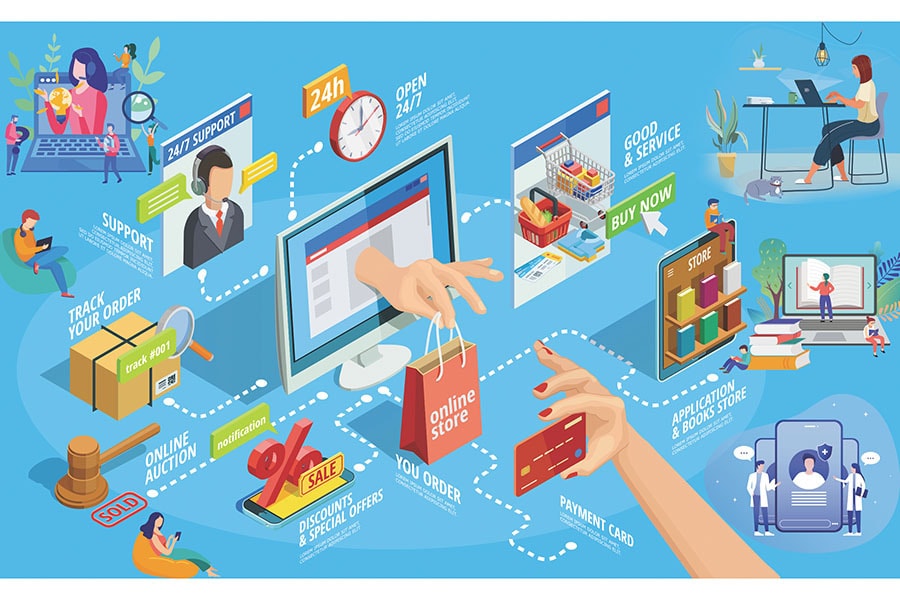Covid-19: How the digital wave gripped India Inc, startups
Across sectors in India, the Covid-19 crisis pushed businesses to embrace technology at a rate they wouldn't have thought possible otherwise. Will it sustain?
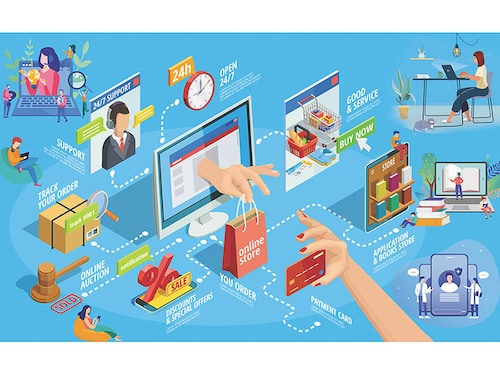

In November, the state government of Maharashtra launched a programme called Swadhyay to improve the online education of children around the state. The programme tapped WhatsApp to provide weekly assessments and learning activities to students in classes 1 to 10. Six weeks into the programme, some 1.1 million students in the state were using the service, according to ConveGenius, a Noida-based education tech-social enterprise.
Maharashtra tapped the expertise of ConveGenius and Leadership For Equity, an organisation working to bring positive change to education systems. A cloud services company, Cloudstrats, is helping the state put the programme on the internet. The programme is open to students of schools affiliated to the state education board and is run by the State Council for Education Research and Training.
Poor households even shared smartphones among themselves so that their children could access these tests and activities, said ConveGenius in a press release.
In such ways, ‘digital transformation’, a term commonly associated with large businesses looking to use technology to improve their operations, is slowly becoming a reality even in small-town India, driven by the sheer need for innovation during a global pandemic. Swadhyay is also an example of how grassroots initiatives in India are playing a role in transforming the country into a market for digital services that investors around the world are increasingly interested in.
“Covid-19 is really providing a tailwind for the segment. In the last six months a considerable amount of demand has been brought forward and broader use has emerged. The amount of progress in a short period of time is really stunning,” said Bob van Dijk, CEO of Naspers, in November, discussing the company’s performance in the six months ended September 30.
South Africa-based Naspers, a multi-billion dollar internet economy group with investments around the world, is a leading investor in ed-tech startups, including Byju’s in India. Helped by the pandemic, “Byju’s saw 180 percent growth in students on top of very high growth rates over the last few years,” van Dijk said at a conference on November 24.
The Covid-19 pandemic has forced businesses and governments to embrace digital transformation with an enthusiasm they had never been able to summon before. From enabling remote working for hundreds of thousands of employees, in some companies, to increased automation of customer support with artificial intelligence (AI)-based bots, businesses and governments have adopted many digital technologies at a rate they never would have accepted earlier. Consulting doctors on the phone zoomed. Students enrolling for online classes surged. The smallest shop owners have taken to selling online and accepting payments through smartphones.
Years of adoption of digital technologies at pre-Covid rates have been compressed into days, a survey by the consultancy McKinsey has found. Many of those changes will be permanent, the survey’s respondents say. In combating the pandemic itself, technology companies are attempting to build ‘digital twins’ of the entire vaccine production process, allowing for rapid simulation of multiple scenarios, with the resulting data helping in accelerating the time to approvals and mass production. And new-age startups have built software to manage the entire supply chain of getting the vaccines out to the world.
In health care, a natural partnership arose with governments tapping even startups to help get the word out on Covid to the masses. For example, an early respondent was Yellow Messenger, a Bengaluru-based AI-based virtual assistant provider. In response to the pandemic, Yellow Messenger, in partnership with Facebook Messenger, was appointed by the National Health Authority of India to provide chatbots to several state governments, including Madhya Pradesh, Punjab and Rajasthan to assist with citizen engagement over WhatsApp and Facebook Messenger.
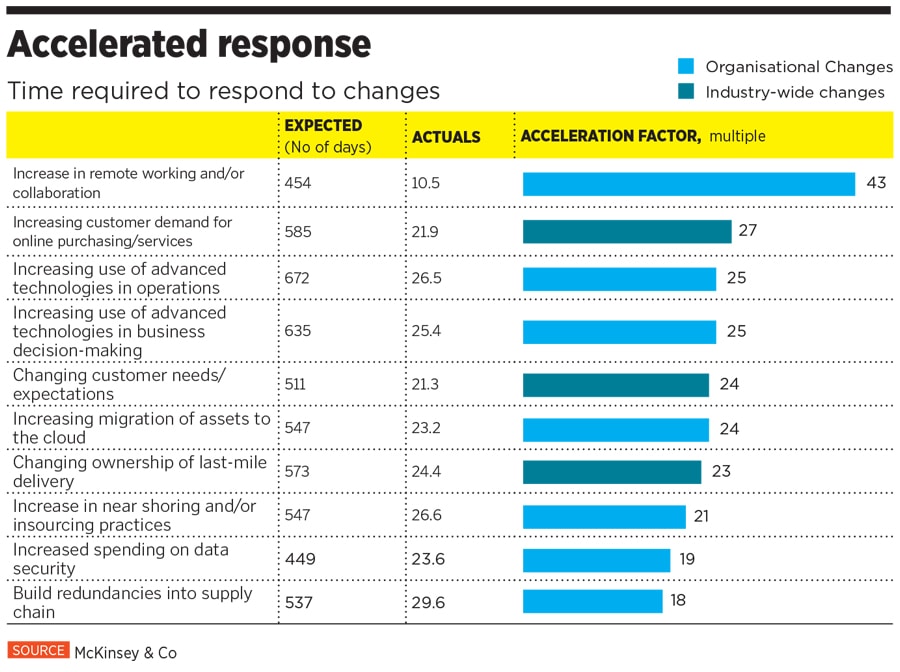
In the wake of the pandemic, technology that was only being used in the back-end is now at the forefront of this health crisis through tools like telemedicine, says Practo Technologies, in an email to Forbes India. This has encouraged countries to implement long-term telehealth tools and enhance the interoperability of electronic medical records.
There is greater acceptance and attention for digital health solutions during the coronavirus crisis and Practo expects that the trend will continue even after the pandemic. Doctors have never been more supportive of digital technologies than now, and patients are slowly getting used to telemedicine as an option of accessing health care. Practo’s telemedicine platform has witnessed a growth of 10x since March 1, the Bengaluru startup says.
As the world sought to develop vaccines and drugs to combat the pandemic, technology companies offered their expertise to accelerate the development and approval processes. An example is the ‘digital twin’ solution built by Atos, a tech services provider, and Siemens, an engineering company.
The two companies together are working with the pharmaceutical industry to improve manufacturing processes with a solution based on a digital replica of the drug production process. This ‘process digital twin’ is currently being pilot tested. It utilises sensors, installed in an actual pharmaceuticals factory, which generate volumes of complex data that are fed to predictive models and real-time analytics programmes to come up with ways to improve the production process.
By equipping each stage of the vaccine manufacturing process with in-line sensors, it’s now possible to collect diverse sets of rich data to understand exactly what is happening in real-time, wrote Niels Thomsen, a group vice president and head of insight for internet of things and AI at Atos, in a blogpost in May. By combining this data with physical, chemical and biological models, it’s possible to build a ‘digital twin’ of the whole vaccine production process.
This digital twin works as a live replica of all physical processes, so that every part of every stage can be fine-tuned and any changes to any process can be simulated in order to understand and test the effects. Thanks to the very latest AI and machine learning (ML) techniques, predictive and prescriptive models can be produced that generate new insights into all aspects of vaccine production.
In research and development, continual simulation at each step makes it possible to test and optimise new processes without losing precious time or resorting to costly investments, Thomson wrote. Scientists can simulate changes in order to test them before they are implemented. In-line measurement using innovative new ‘quality by design’ models ensures that processes are robust and produce best-quality results. Crucially, this new ability to monitor quality and make adaptations during production reduces waste and accelerates times-to-market.
As various drug companies came closer to getting their Covid vaccines into the market, it was time to figure out the logistics of getting the antidote out to the world. LogiNext, a logistics and supply chain automation and intelligence provider, has built a vaccine supply-chain management and tracking platform.
Dhruvil Sanghvi, CEO of LogiNext, says, “We have been working hard for a while now on this vaccine-tracking solution, including some key features for the cold chain. We’re very proud to launch the first solution to manage a complex supply chain around the Covid vaccine from manufacturing facilities all the way till the last mile.”
The solution is based on the company’s flagship platform called LogiNext Mile, an all-mile transportation automation platform that can be used for tech-enabled management of vaccine distribution. The software-as-a-service platform can be deployed for complete visibility and tracking of the vaccine distribution from the point of origin at the manufacturing plants to the last mile, Loginext said in a press release on December 15.
The solution can be used for the entire chain or a part of the solution can be used for visibility and tracking, demand forecasting and order scheduling and detailed analytics.
“Talks are ongoing for pilots with several organisations and our team of engineers has worked round the clock to get the best-in-class solution available,” says Manisha Raisinghani, CTO of LogiNext.
In the meantime, as people wait to get their vaccines, remote working and working-from-home is a reality for hundreds of millions around the world. In India’s IT outsourcing sector, companies had to not only scramble to get their own employees equipped to work from home, but also help their customers—some of the biggest companies around the world—do the same.
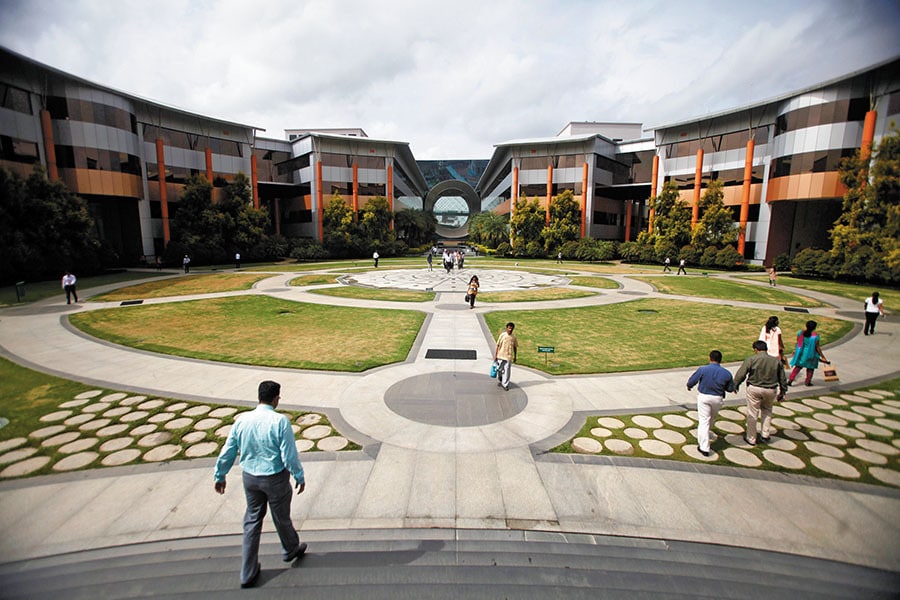 In a matter of weeks in March, Infosys got 93 percent of its quarter of a million staff equipped to work remotely over the next months, that number went up to 99 percent.
In a matter of weeks in March, Infosys got 93 percent of its quarter of a million staff equipped to work remotely over the next months, that number went up to 99 percent.
“We were huge beneficiaries of the technology investments that we’ve made over the years and the security investments that we made,” said Salil Parekh, CEO of Infosys, India’s second-biggest IT services company, in an interview to Forbes India in August. In a matter of weeks, starting the second half of March, Infosys got 93 percent of its quarter of a million staff equipped to work remotely. Over the next few months, that proportion went up to 99 percent.
Even after the world has come to grips with the pandemic, a hybrid model of working from offices for some time and working from homes for the rest of the time is here to stay, said Rishad Premji, chairman of Infosys’s rival Wipro, to analysts in November.
Such shifts are bringing up the need for new technologies as well, such as ‘desktop-as-a-service’ or DaaS. In 2021, demand for DaaS will contribute to a projected 30 percent increase in spending on public cloud services, says Ananda Mukerji, founder and chairman of Anunta Tech, a cloud services provider.
“We expect to see huge adoption of DaaS solutions by organisations of all sizes to increase productivity and maximise return on investment, while keeping employee safety and convenience at the core,” says Mukerji. With the gig economy booming in the country, companies will start to depend more on staff working in freelancing or contract-based models, and this will need solutions like DaaS so that these workers can access business applications reliably and securely, he adds.
While the IT and enterprise software sectors predominantly focus on markets such as the US, 2020 also saw the rise of startup tech providers to India’s millions of small- and medium-sized businesses. Such companies ranged from those providing digital ledgers to small merchants or just helping them get online, to those using sophisticated software algorithms to give loans to people without adequate credit history. And funding for such startups rose too.
Dukaan, for instance, was started in 2020. It is a do-it-yourself platform for a small merchant with no programming skills to set up his own online store within 30 seconds, according to the startup. Each merchant gets a unique store link on which to showcase products or services and further share this link with customers on social media platforms.
With the pandemic acting as a tailwind, Dukaan was used by over 2.7 million merchants in the three months since its launch. Merchants have generated over 600,000 orders, resulting in a total gross merchandise value of over `100 crore, the tech startup said in a press release in October, announcing it had raised $6 million in seed funding from venture capital firms Matrix Partners India, Lightspeed India Partners and a clutch of other investors.
“Our mission is to enable each and every small retailer to launch, compete and grow their business online, without ever worrying about technology,” says Suumit Shah, CEO and co-founder of Dukaan.
“What got us most excited about Dukaan was the team and their missionary zeal in enabling small retailers to go online. We are proud to support the Dukaan team from day one, as they create this platform and leverage the digital tailwind that almost every industry and sector is seeing today,” says Akshay Bhushan, a partner at Lightspeed India.
Another example is payments and banking technology company, Cashfree, which registered a surge in the adoption of its payment solution for lenders during the pandemic-induced lockdown period. Launched in March 2020, Cashfree’s lending suite saw over 5 million transactions through November. Cashfree has signed on over 300 NBFCs and lending companies this year, it said in a press release on December 22.
Cashfree’s lending suite is used by businesses to facilitate instant loan disbursals from a lender’s bank account via IMPS or UPI, verify a borrower’s bank account and allow borrowers to authorise lenders to debit their accounts through an automated loan repayment collection system in the form of subscriptions via e-mandate and UPI.
Akash Sinha, CEO and co-founder of Cashfree, says, “With our lending payments suite, we have tackled the surge in loan requests by speeding up the process of lending and collection while enhancing the end customer experience. Growing steadily month-on-month, we saw the highest jump in August when we recorded a 187 percent growth in the gross merchandise value in our lending suite.”
Sinha adds: “Our aim has always been to provide flawless experiences and unparalleled services across the board, including lenders, agents, banks and borrowers. We see a lot of potential for the growth of digital payments in the NBFC sector and we are also working directly with lending platforms and banks to bring more efficiency, to both assist the lending business and to strengthen the payments infrastructure.”
Another area in which the rapid adoption of technology has helped businesses expand and changed consumer behaviour is in India’s growing ecommerce sector. Flipkart witnessed new user growth of close to 50 percent right after the lockdown, with tier 3+ regions registering the highest growth of 65 percent during the ‘Unlock’ (July-September) phase. Consumers from tier 2 and tier 3+ regions also spent the most time on the platform, signalling a continuing rise in user engagement and a shift in shopping preferences, the company said in a press release on December 18.
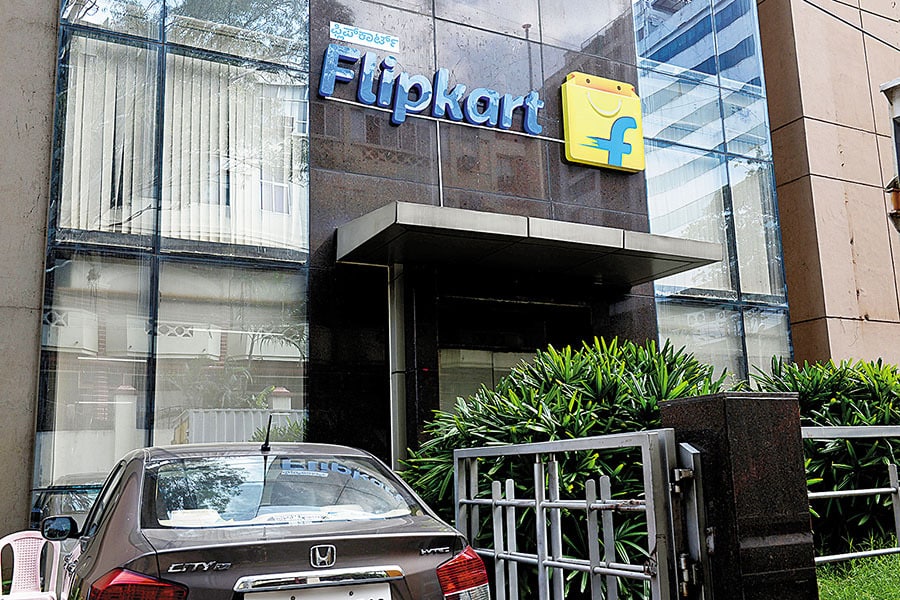 Flipkart saw increased demand from customers in tier 2 and tier 3+ towns
Flipkart saw increased demand from customers in tier 2 and tier 3+ towns
Especially to help first-time users, Flipkart introduced two new capabilities—a voice assistant in its online grocery store, and vernacular interfaces in languages including Hindi, Tamil, Telugu and Kannada. As more consumers took to ecommerce in 2020, a growing preference to shop in their local language was seen. The adoption of native languages saw a 2.5x increase from pre-Covid to the festive season (January to November 2020), Flipkart said.
The increased adoption of ecommerce also helped digital payments, according to Flipkart. Adoption of India’s Unified Payments Interface on the Flipkart platform increased nationally by 4.5x between January and August, Flipkart said.
The Covid crisis has brought about years of change in the way companies in all sectors and regions do business, according to a survey by McKinsey and Co, which released the results of the survey in an October report. Companies have accelerated the digitisation of their customer and supply-chain interactions and of their internal operations by three to four years. “And the share of digital or digitally enabled products in their portfolios has accelerated by a shocking seven years,” McKinsey said in its report. Nearly all respondents said that their companies have implemented at least temporary solutions to meet many of the new demands on them, and much more quickly than they had thought possible before the crisis.
Some of the most telling findings of the survey are about how quickly companies implemented workable solutions in various areas. For example, among all the respondents to the survey, it took their companies an average of only 10.5 days to increase remote working and collaboration capabilities. In pre-Covid times the same would have taken 454 days, the survey found.
It has been a year of digital discovery.
First Published: Dec 29, 2020, 15:43
Subscribe Now